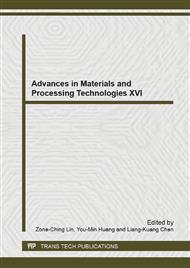p.19
p.25
p.31
p.39
p.47
p.53
p.60
p.68
p.76
Effect of Temperature on Cyclic Behavior of AZ31 Mg Alloy Sheet
Abstract:
Magnesium alloy sheets have a potential to be widely used in many fields of industry due to their excellent lightweight property. Although magnesium alloys have low ductility at the room temperature due to their hexagonal close-packed structure, their formability can be improved at elevated temperatures. Therefore, warm press-forming of magnesium alloy sheets is an attractive technology. The objective of the present work is to investigate the cyclic plasticity behavior of an AZ31 sheet at elevated temperatures by performing cyclic tension-compression experiments. The cyclic deformation mechanism is examined by measuring the crystallographic orientation distributions by means of X-ray diffraction method at each stage of the cyclic deformation. The present findings are summarized as follows: (1) Stress-strain responses of an AZ31 sheet were investigated at various temperatures (R.T, 100, 150 and 200°C) at strain rates of 0.001, 0.01 and 0.05 s-1. The flow stresses were insensitive to the strain rate at the room temperature, however the strain rate dependency of the flow stress becomes dominant at elevated temperatures of over 100 °C.(2) Cyclic plasticity behavior of the sheet at various elevated temperatures (R.T, 100, 150 and 200 °C) at strain rates of 0.001, 0.01 and 0.05 s-1 were investigated by performing warm in-plane cyclic compression-tension test. Similarly to the uniaxial tension test, apparent temperature and strain rate dependencies of the flow stress were observed at temperatures of over 100 °C. (3) At the room temperature an unusual cyclic stress-strain curve, which is very different from that of bcc and fcc metals, was observed. From the texture measurement it was found that such a specific stress-strain characteristic is due to its twinning and detwinning deformation mechanism.(4) In contrast, at an elevated temperature of 200 °C, the usual cyclic stress-strain response, which is similar to one appearing in most of metallic materials, was observed. This is because the major deformation mechanism at an elevated temperature is the slip, rather than twinning/detwinning, since the CRSS decreases drastically with increasing temperature.
Info:
Periodical:
Pages:
47-52
Citation:
Online since:
May 2014
Keywords:
Price:
Сopyright:
© 2014 Trans Tech Publications Ltd. All Rights Reserved
Share:
Citation:


